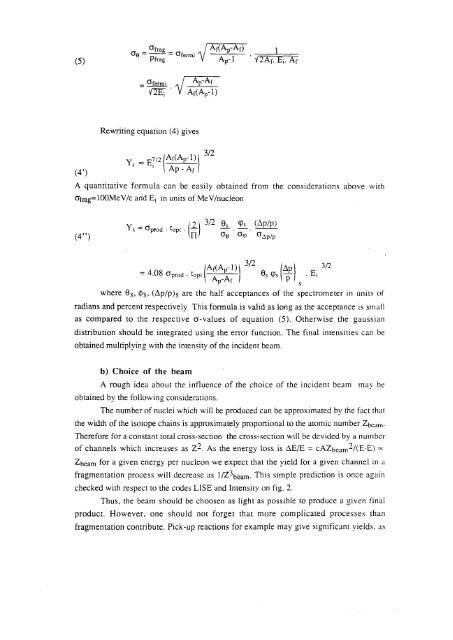Radioactive beams by fragmentation and ISOL techniques - CERN
Radioactive beams by fragmentation and ISOL techniques - CERN
Radioactive beams by fragmentation and ISOL techniques - CERN
Create successful ePaper yourself
Turn your PDF publications into a flip-book with our unique Google optimized e-Paper software.
(5)<br />
(4,)<br />
A A -A B<br />
69 = % = Gfumi IV ET`<br />
Z _ Sym DE V A;(Ap—l) Ap’Af<br />
Rewriting equation (4) gives<br />
YOc E?/2/UXP-1<br />
S (X)) P ‘ Af 3/2<br />
A quantitative formula can be easily obtained from the considerations above with<br />
of,ag=l()()MeV/c <strong>and</strong> Ei in units of MeV/nucleon<br />
YS=opmd.tOp[.(l) 3/2 Q?—.&.<br />
4,,) H G9 GQ? 6Ap/p<br />
Z 4.08 (5,,,.,., . t.,,,,(§§<br />
where SS, os, (Ap/p)S are the half acceptances of the spectrometer in units of<br />
radians <strong>and</strong> percent respectively This formula is valid as long as the acceptance is small<br />
as compared to the respective o—values of equation (5). Otherwise the gaussian<br />
distribution should be integrated using the error function. The final intensities can be<br />
obtained multiplying with the intensity of the incident beam.<br />
b) Choice of the beam<br />
A rough idea about the influence of the choice of the incident beam may be<br />
obtained <strong>by</strong> the following considerations.<br />
3/2 i*’l 30<br />
9, (D, . Ei<br />
The number of nuclei which will be produced can be approximated <strong>by</strong> the fact that<br />
the width of the isotope chains is approximately proportional to the atomic number Zbcam.<br />
Therefore for a constant total cross-section the cross-section will be devided <strong>by</strong> a number<br />
of channels which increases as Zi. As the energy loss is AE/E = cAZbcami/(EE)<br />
Zbeam for a given energy per nucleon we expect that the yield for a given channel in a<br />
<strong>fragmentation</strong> process will decrease as l/Zjbcam. This simple prediction is once again<br />
checked with respect to the codes LISE <strong>and</strong> Intensity on fig. 2.<br />
Thus, the beam should be choosen as light as possible to produce a given final<br />
product. However, one should not forget that more complicated processes than<br />
<strong>fragmentation</strong> contribute. Pick—up reactions for example may give significant yields. as OCR Output<br />
Q















